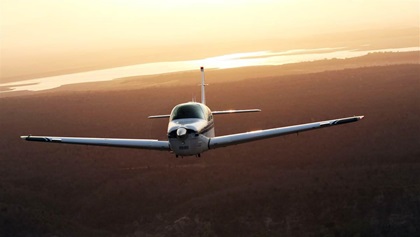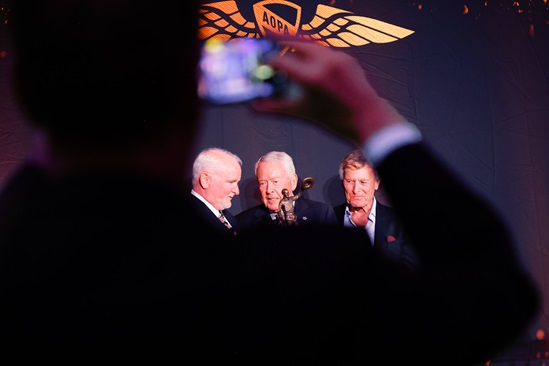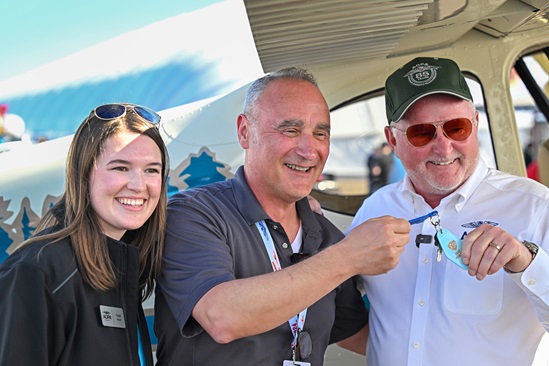
The Bahamas needs you
Visiting islands not affected by Dorian helps the whole country
By Julie Summers Walker
“We are asking our travel partners—like private pilots—to consider keeping their flight plans to the islands that were not affected.”
It’s not a plea for money nor for thoughts and prayers, but for support. “The best way to help the Bahamas is by traveling to the Bahamas,” said Dionisio D’Aguilar, minister of tourism and aviation.
Hurricane Dorian swept through the 700-island chain in September, devastating the islands of Grand Bahama and Abaco. Recovery is ongoing and general aviation has been part of the relief programs. But the island country is more than just those two islands. “We are still reeling from the devastation Hurricane Dorian brought to our beautiful, beloved country,” said D’Aguilar. “We have family, friends, and colleagues with ties to both Abaco and Freeport….We are praying for the safety of our countrymen. Amid all the devastation, we pledge continued support for our tourism industry, the key economic engine that fuels our country.”
Tourism is the number one industry in the Bahamas and contributes to half of the country’s gross domestic product. Now that the storm has passed, the country—while continuing relief efforts—is communicating that, of the 16 most-visited islands, 14 are open and unaffected by the hurricane. “More than ever we need you to come on vacation,” D’Aguilar said. “That’s the only way we can help our brothers and sisters in the north.”
Email [email protected]

AOPA Air Safety Institute
Up is down
What to do when your feelings don’t matter
By Alicia Herron
Spatial disorientation is the mistaken perception of your position and motion relative to the Earth. More simply, any time the instruments indicate one attitude and the signals from your body tell you something else, you are experiencing spatial disorientation. You might see a turn on the instruments, but feel straight and level, or vice versa.
As you may imagine, this can be a highly confusing sensation (see “Proficiency: Flight Fright,” p. 93). These warring senses can lead a pilot to put in controls to correct a flight attitude that doesn’t exist—for example, attempting to level the wings when not actually banked. This confusion, if not caught, can lead to loss of control of the aircraft. Any condition that deprives a pilot of natural, visual references such as the horizon can rapidly cause spatial disorientation.
We tend to think that lack of visual reference means in the clouds. So, if you fly VFR, does that mean that you’re immune to spatial disorientation? No. The flight rules you operate under don’t preclude susceptibility to disorientation. Flying in instrument meteorological conditions (IMC) is serious business, but VFR conditions such as haze, darkness, or flight over indistinct terrain (over water, for example) also can lead to disorientation.
You’ve done some instrument training before—the FAA requires private pilot applicants to receive at least three hours of it prior to the checkride. If you didn’t go on to get your instrument rating, that’s probably all the significant IFR training you’ve received. Those three hours were meant to teach you the basics, and to give you enough skill to be able to maintain control over the airplane in an emergency (yes, VFR into IMC flight is an emergency if you’re not proficient in instrument flight), and reverse course. Disabuse yourself of the dangerously false idea that any pilot with just a few hours of instrument training is capable of prolonged flight in instrument meteorological conditions. They aren’t. Yet too often, pilots with extremely limited instrument experience overestimate their skill or underestimate the conditions and attempt prolonged or deliberate VFR into IMC flight—only to end up a tragedy.
Spatial disorientation accidents aren’t limited to noninstrument-rated pilots. When flying in actual IMC, equipment failure can make even the most proficient instrument pilot that much more prone to spatial disorientation. If you’re instrument rated, you can prepare for this unlikely possibility by keeping your partial panel skills sharp. And many modern aircraft, especially those used for long IFR cross countries, have highly capable autopilots—but are you sure you could fly an approach without one? Even if you are sure, consider the old-school idea of hand-flying approaches to develop proficiency.
A great way to gain respect for spatial disorientation is to feel it yourself under controlled conditions. Ask your instructor to spatially disorient you aloft (in VMC, of course) or try it in a simulator—even partial-motion sims have been known to cause disorientation. The challenge of fighting through spatial disorientation may change your perspective on just how difficult it is to overcome, and may help explain why no pilot—no matter their certificate level or experience—is immune.
Web: airsafetyinstitute.org/safetyvideos/TOL_series
Email [email protected]
Turn on your notifications
On your feed
Fly with AOPA
 AOPA app’s Pilot Passport: End the year right
AOPA app’s Pilot Passport: End the year right
The top 80 pilots using the Pilot Passport function on the AOPA app to check in at airports during AOPA’s eightieth anniversary year will receive the 288-page coffee table book Freedom to Fly: AOPA and the History of General Aviation in America, plus an additional prize. In addition, the top three all-time pilot check-ins will be awarded an AOPA tactical jacket valued at $144 from the AOPA Pilot Gear store. The versatile clothing item is a great addition to a pilot’s winter, fall, or spring wardrobe, and it could be yours just for using the Pilot Passport check-in feature in the AOPA app. The community of pilots using the interactive check-in feature continues to grow and has recorded some impressive numbers since the feature was unveiled in April. To date, pilots using the Pilot Passport feature have recorded almost 50,000 check-ins, earned more than 13,200 badges, and uploaded more than 3,200 photos. Those who share their airport experiences on Facebook and Twitter can widen their social media footprint by posting photos and videos to Instagram, too.
Web: aopa.org/travel/pilot-passport
Looking for more?
Instagram: @flywithaopa, Twitter: @aopa, Facebook: AOPA: Your Freedom to Fly
Post of the month

VÁMONOS A MEXICO
Starting December 10, all 51,000 BasicMed pilots will be able to travel to Mexico in their aircraft. #flywithaopa #basicmed Photo credit: @cloudsandcamera
Use #flywithaopa for your chance to be featured!

Addressing MedXpress
AOPA responding to airman concerns
By Gary Crump
With BasicMed now up and running, more than 51,000 pilots no longer contend with the FAA Form 8500-8 airman medical application, aka MedXpress. However, for commercial pilots, new student pilots, pilots who don’t meet eligibility requirements or fly outside the scope of BasicMed, MedXpress is a fact of life.
On August 13, the FAA published in the Federal Register a request for comments on three FAA Forms: the airman medical application, Form 8500-8; and two eye-evaluation forms, 8500-7 and 8500-14. The request is to collect data on the necessity of information requested on the medical application form; the accuracy of the estimate of burden on the applicant who completes the form; ways that the FAA can “enhance the quality, utility, and clarity of the information collection;” and ways the burden “could be minimized without reducing the quality of the collection information.”
The MedXpress form has for decades been problematic for airmen because of the complexity of the language used and the amount of detailed medical information the FAA requires. Because it is a federal legal document, the potential penalties are severe for anyone who “knowingly and willingly falsifies, conceals or covers up by any trick, scheme, or device a material fact, or who makes any false, fictitious or fraudulent statements or representations, or entry….”
With the FAA’s request for comments, we can offer the government our thoughts on the medical certification process. The regulatory process of medically qualifying pilots is complicated by virtue of the very bureaucracy of the system and the FAA’s mandate for aviation safety. The data we disclose on the application becomes the basis of an “investigation” conducted by the FAA based upon the information provided on the 8500-8 and supplemental medical information provided by the pilot.
A medical history that is considered inconsequential and benign by your physician or specialist may be viewed as potentially disqualifying by the FAA. And, information about FAA policies often becomes known to the airman only when the FAA asks for more information or issues a letter of denial. That’s the value of AOPA’s Pilot Information Center medical certification staff who live in this world every day and work to make sense of and educate our members about how the system works. If you have questions about your 8500-8 form, call AOPA at 800-USA-AOPA
Web: aopa.org/pps
Gary Crump is senior director of the AOPA medical certification division of the AOPA Pilot Information Center.
Tips from PIC
What’s so great about the FAA?
By Jon Gandy
Often, the FAA gets a bad rap, but it provides a lot of value. For instance, did you know that you can get every FAA flight training handbook for free on faa.gov? The same is true for airman certification and practical test standards. The Aeronautical Chart User’s Guide will tell you what every oddball symbol is for any section or instrument approach plate. And the goodies aren’t just limited to digital products. The FAA offers some cool services as well.
Is something published on an instrument approach confusing? Ask the office that develops and publishes them through the Instrument Flight Procedures Gateway (faa.gov/air_traffic/flight_info/aeronav/procedures). If you fly off to a destination vacation and your wallet with pilot certificate somehow ends up at the bottom of the ocean, not only can you use the Airman Online Services portal to order a replacement plastic card, you also can request a temporary authority to exercise certificate privileges. A few minutes later the FAA will email you a PDF recognizing your certificates and give you the authority to fly.
Are you having trouble getting in touch with the FAA about a medical issue? Regional flight surgeons have the same systems as the FAA, but usually more of an ability to talk with you. So, while you may not be able to twist anyone’s arm, you can at least get an update on your status.
The next time you wonder what on Earth it is that the FAA is doing for general aviation, you don’t have to scratch your head. Feel free to give AOPA a call at 800-872-2672 and find out more about the products and services available to you for free from the FAA.
Jon Gandy is an aviation technical specialist at AOPA.


